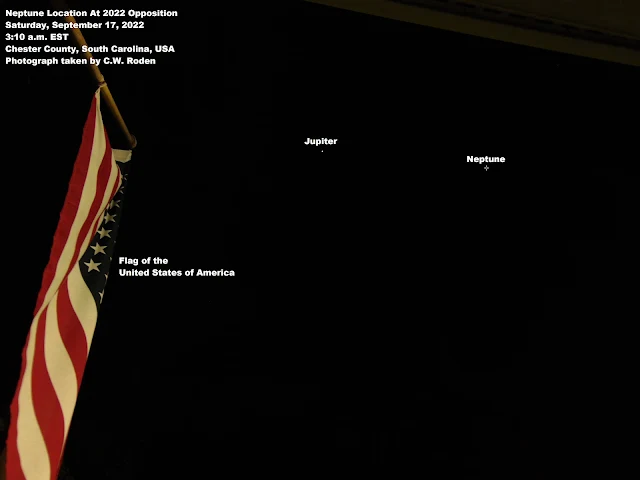 |
| Photograph of Neptune taken by NASA's Voyager 2 in 1989. |
Good evening, fellow Stargazers!
This evening our Earth will sweep between the Sun and the eighth planet in our Solar System, the gas giant planet Neptune on the evening of Friday, September 16th and morning of Saturday, September 17th, 2022, placing the distant planet in opposition in our sky.
Because of its blue color, its impossible to see Neptune in the night sky with the naked eye. This world is about five times fainter than the dimmest star you can see on a moonless night under a dark sky dome.
If y'all know right where to look, you can find it with a good pair of binoculars, or a telescope -- and even with those optical aids, at nearly 3 billion miles away, it would only look like a small, faint disk at best.
At the present time Neptune is between Jupiter and Saturn in the night sky along the ecliptic, closer to Jupiter in front of the faint Constellation Aquarius.
Sadly, capturing Neptune with the 35X Optical Zoom Lens of my camera, even at full magnification, is virtually impossible. So in my photo, I marked the approximate location of Neptune in the sky in relation to Jupiter during the time of its opposition using the Flag of the United States on my porch in the foreground for scale.
At opposition when the Earth and Neptune are at their closest in the orbit around the Sun, Neptune’s distance from us is a whopping 2.7 billion miles (or about 28.90 AUs) -- about 240 light-minutes Earth!
Named for the Roman god of the sea, Neptune is the fourth largest planet in our Solar System and (officially) the farthest of the eight main planets -- not counting Pluto which is STILL A &%$#@! PLANET!
The planet was first observed at the Berlin Observatory by astronomers Johann Gottfried Galle and Heinrich Louis d'Arrest on Wednesday, September 23, 1846.
Neptune has 14 known moons, the largest of which is Triton.
Even though its the smallest of the
giant gas planets in the Solar System, Neptune has a diameter of 34,503 miles (or 55,528
kilometers). To give y'all an idea of just how big that is, around 57 Earths could fit inside of Neptune's radius.
At its far-flung distance, the planet Neptune orbits the Sun once every 165 Earth years at an average distance of around 30.1 AU (about 2.8 billion miles, or 4.5 billion kilometers).
Because Neptune’s orbit around the sun is so huge, Neptune’s yearly opposition
date with the Earth comes only a few days later each year. The next opposition of Neptune to Earth is on Tuesday, September 19, 2023.
Neptune is not the only planet to come into opposition with Earth this month. Jupiter will also be in opposition to Earth on Monday, September 26th. Until then, y'all keep your eyes to the night skies, ya hear?











